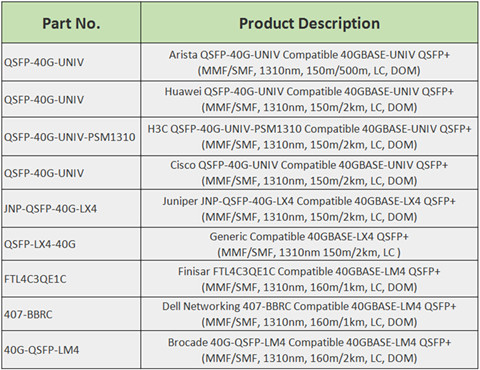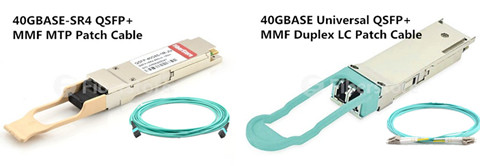Marketing
Migrate to 40G Ethernet With SMF&MMF 40G QSFP+ Transceiver
Due to the server consolidation, virtualization, and performance improvements, data center designers are eager to migrate from 10G to 40G to better meet their network demand. However, there are many 40G optical transceivers and cabling solutions available for sale, such as QSFP-40G-SR4, QSFP-40G-LR4, QFX-QSFP-40G-ESR4, as well as QSFP DAC/AOC cables. So, which one is the most cost-effective solution? No one can give you an exact answer without the detailed information. The above 40G optical transceivers and cables have already been introduced in the previous articles. Today, I am about to shed light on a new QSFP optical transceiver—SMF&MMF 40G QSFP+ (QSFP-40G-UNIV) and its function in 40G migration.
What Is SMF&MMF 40G QSFP+ Transceiver?
The typical fiber optic transceiver may either operate on multimode fiber or single-mode fiber. For example, the Cisco QSFP-40G-SR4, QSFP-40G-LR4 can only operate over multimode fiber for up to 150m, and single-mode fibers with a link length of 10km, respectively. However, a SMF&MMF 40G QSFP+ transceiver as the name implies, can be used with both multimode and single-mode fibers without the need for any software/hardware changes to the transceiver module or any additional hardware in the network. This is usually accomplished (seen in Figure 1) by combining four 10G optical channels at different wavelengths (1270, 1290, 1310, and 1330 nm) inside the transceiver module to transmit and receive an aggregate 40G signal over a single pair of multimode or single-mode fibers.

40GBASE-UNIV and 40GBASE-LX4 QSFP+ Transceiver Overview
Vendors like Huawei, Arista, H3C and Cisco all offer QSFP-40G-UNIV optical transceivers. Based on IEEE 40GBASE-LR4 specifications, QSFP-40G-UNIV operates in the 1310nm band. It uses a duplex LC connector and supports distances up to 150 m over OM3 or OM4 multimode fiber and up to 500 m over single-mode fiber (different vendor may have different specifications). Besides the QSFP-40G-UNIV transceivers, 40GBASE-LX4 QSFP+ transceiver is the other type of the SMF&MMF 40G QSFP+. Take Juniper JNP-QSFP-40G-LX4 as an example, the Juniper 40 Gbps LM4 QSFP+ optical transceiver, part of the Juniper family of optical transceivers, is optimized to fully leverage 40 Gigabit Ethernet (GbE) switches and routers. Figure 2 shows FS.COM SMF&MMF 40G QSFP+ transceiver solutions.

Why Should We Use SMF&MMF 40G QSFP+ Transceiver to Achieve 40G Migration?
With the increase in data center bandwidth requirements, migration to 40G for switch to switch connections is in higher demand. SMF&MMF 40G QSFP+ transceiver is designed to allow for seamless migrations from existing 10G to 40GbE networking without requiring a redesign or expansion of the fiber network. Besides, this transceiver also provides a cost-effective solution to migrate from multimode to single-mode fiber, allows a single-mode fiber infrastructure for distances up to 500m. The following part presents the unique merits of SMF&MMF 40G QSFP+ transceiver.
- Upgrade to 40G Without Additional Cables
The existing QSFP+ transceiver like QSFP+ SR4, QSFP+ CSR4 and QSFP+ LR4 optics, utilizes four independent 10G transmitters and receivers for an aggregate of 8 cables for 40G links. Therefore, customers have to add additional fiber to increase the number of 40G links. However, a SMF&MMF QSFP+ uses duplex LC connector that is consistent with the existing 10G connections, which are also commonly MMF cables with duplex LC connectors. Therefore, a SMF&MMF QSFP+ allows the same cables to be used for direct 10G connections to direct 40G connections, resulting in zero-cost cabling migration. What’s more, by deploying the SMF&MMF 40G QSFP+ transceiver, customers increase the number of 40G links by 4 times without making any changes to their fiber infrastructure, which greatly expand network scale and performance. Figure 3 shows the difference between QSFP+ SR4 QSFP+ and 40GBASE-UNIV universal modules.

- Realize the Migration From Multimode to Single-mode Fiber
There is a increasing trend for data center designers to move to single-mode optical solutions due to the distance limitations of the multimode cabling system. When data rates increase from 40G to 100G and beyond to 400G, it is just not that easy to move to single-mode cable system for cost effectiveness. Because network managers needs to replace all the old multimode optical devices into brand new single-mode equipment, which usually costs a large mount of money. However, with SMF&MMF QSFP+ optic module, migrating to 40G and 100G will be simpler. As SMF&MMF QSFP+ interoperates with 10km QSFP-LR4 optics, it s a cost effective solution for SM fiber infrastructure for distances up to 500 m.
- Simplify the 40G Cabling System
The SMF&MMF 40G QSFP+ transceiver offers the unique advantage of operating on both multimode and single-mode fiber without any requirement for additional hardware or software. Customers can consolidate their optics and use SMF&MMF QSFP + in their network irrespective of the fiber type, which makes full use of the existing cabling systems, reduces the cost of deployment and of support, and simplify purchasing and deployments.
Conclusion
SMF&MMF 40G QSFP+ transceiver offers a cost-effective transition path for migrations to single-mode fiber in data centers with a single transceiver that bridges the gap between multimode and single-mode optics, enabling data centers running at 10G today to seamlessly upgrade to 40G without having to re-design or modify the cable infrastructure. FS.COM offers a full range of 40G optical transceivers and cables that ensure the smooth migration to 40G data center deployments. Products like QSFP-40G-SR4, QSFP-40G-LR4, QFX-QSFP-40G-ESR4, as well as QSFP DAC/AOC cables are well-tested and fully compatible with major brand. The SMF&MMF 40G QSFP+ transceivers are also offered with very competitive price but high quality. Contact us if you are interested.
Post je objavljen 14.10.2016. u 08:18 sati.